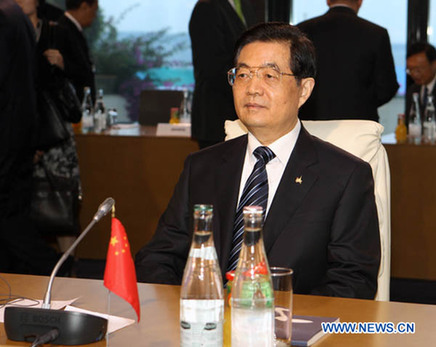China in face of the West's 'Great Stagnation'
- By John Ross
 0 Comment(s)
0 Comment(s) Print
Print E-mail
China.org.cn, November 4, 2011
E-mail
China.org.cn, November 4, 2011
 |
|
Chinese President Hu Jintao attends the Group of Twenty (G-20) summit in Cannes, France, Nov. 3, 2011. [Xinhua] |
To put numbers on this, the newly published US 3rd quarter 2011 GDP figure show that for the first time US economic output has regained its level at the peak of the previous business cycle at the end 2007. But taking the nearly four year period since total US annual growth was only 0.1 percent. Furthermore annualized US growth in the 3rd quarter of 2011, 2.6 percent, is far from the type of rapid expansion you would expect during the 'recovery' period of a US economic cycle. To give a comparison, the third quarter of 2011 is the 15th quarter after the peak of the previous US business cycle. During the previous slowest recovery in US post-war history, following the recession of 1980, by the 15th quarter of the business cycle annualized US economic growth was 8.3 percent- the present US recovery is less than a third as fast.
The situation in Europe and Japan is worse. Data is not yet available for the 3rd quarter of 2011 for these economic centers, but the parameters are already clear. In neither has output regained its pre-crisis peak three and a half years after the economic downturn began. In the 2nd quarter of 2011, the latest available data, EU GDP was still 1.9 percent below its pre-crisis level and in Japan it was 6.1 percent below - this latter figure being worsened by the earthquake and tsunami.
Turning to trade, imports by the developed economies during the last year have almost stopped growing. They were 6.4 percent below their pre-crisis peak in June 2010 and 6.1 percent below in the August 2011, the latest available data. Imports into the EU were shrinking - 7.8 percent below their pre-crisis peak in June 2010 and 9.6 percent down in August 2011.
Given extremely slow growth in the developed economies, and that examination of underlying macro-economic factors such as savings and investment indicates no reason to expect a substantial growth acceleration, this places China in a new international economic situation. For almost the entire period since China launched its economic reforms in 1978, it has been growing more rapidly than other economies but in an international context where the developed economies were growing significantly. The only serious previous recession in the advanced economies during China's reform period was right at its beginning, in 1980-81, when China was scarcely integrated in the international economy. The international slowdowns in 1990 and 2000 were brief and mild and while the 1998 South East Asian financial crisis impacted China significantly, it did not originate in the developed economies.






Go to Forum >>0 Comment(s)